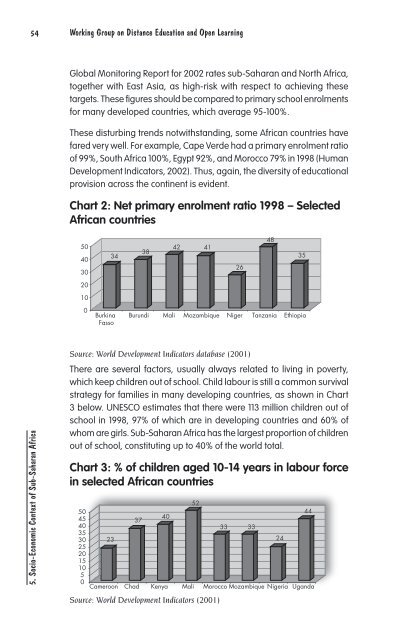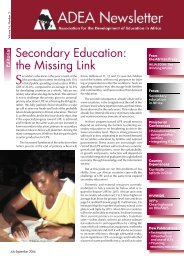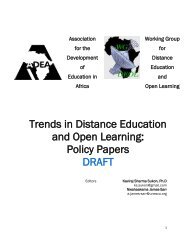Technological Infrastructure and Use of ICT in Education in ... - ADEA
Technological Infrastructure and Use of ICT in Education in ... - ADEA
Technological Infrastructure and Use of ICT in Education in ... - ADEA
You also want an ePaper? Increase the reach of your titles
YUMPU automatically turns print PDFs into web optimized ePapers that Google loves.
54 Work<strong>in</strong>g Group on Distance <strong>Education</strong> <strong>and</strong> Open Learn<strong>in</strong>g<br />
Global Monitor<strong>in</strong>g Report for 2002 rates sub-Saharan <strong>and</strong> North Africa,<br />
together with East Asia, as high-risk with respect to achiev<strong>in</strong>g these<br />
targets. These figures should be compared to primary school enrolments<br />
for many developed countries, which average 95-100%.<br />
These disturb<strong>in</strong>g trends notwithst<strong>and</strong><strong>in</strong>g, some African countries have<br />
fared very well. For example, Cape Verde had a primary enrolment ratio<br />
<strong>of</strong> 99%, South Africa 100%, Egypt 92%, <strong>and</strong> Morocco 79% <strong>in</strong> 1998 (Human<br />
Development Indicators, 2002). Thus, aga<strong>in</strong>, the diversity <strong>of</strong> educational<br />
provision across the cont<strong>in</strong>ent is evident.<br />
Chart 2: Net primary enrolment ratio 1998 – Selected<br />
African countries<br />
<br />
<br />
<br />
<br />
<br />
<br />
<br />
<br />
<br />
<br />
<br />
<br />
<br />
<br />
<br />
<br />
5. Socio-Economic Context <strong>of</strong> Sub-Saharan Africa<br />
Source: World Development Indicators database (2001)<br />
There are several factors, usually always related to liv<strong>in</strong>g <strong>in</strong> poverty,<br />
which keep children out <strong>of</strong> school. Child labour is still a common survival<br />
strategy for families <strong>in</strong> many develop<strong>in</strong>g countries, as shown <strong>in</strong> Chart<br />
3 below. UNESCO estimates that there were 113 million children out <strong>of</strong><br />
school <strong>in</strong> 1998, 97% <strong>of</strong> which are <strong>in</strong> develop<strong>in</strong>g countries <strong>and</strong> 60% <strong>of</strong><br />
whom are girls. Sub-Saharan Africa has the largest proportion <strong>of</strong> children<br />
out <strong>of</strong> school, constitut<strong>in</strong>g up to 40% <strong>of</strong> the world total.<br />
Chart 3: % <strong>of</strong> children aged 10-14 years <strong>in</strong> labour force<br />
<strong>in</strong> selected African countries<br />
<br />
<br />
<br />
<br />
<br />
<br />
<br />
<br />
<br />
<br />
<br />
<br />
<br />
<br />
<br />
<br />
Source: World Development Indicators (2001)

















